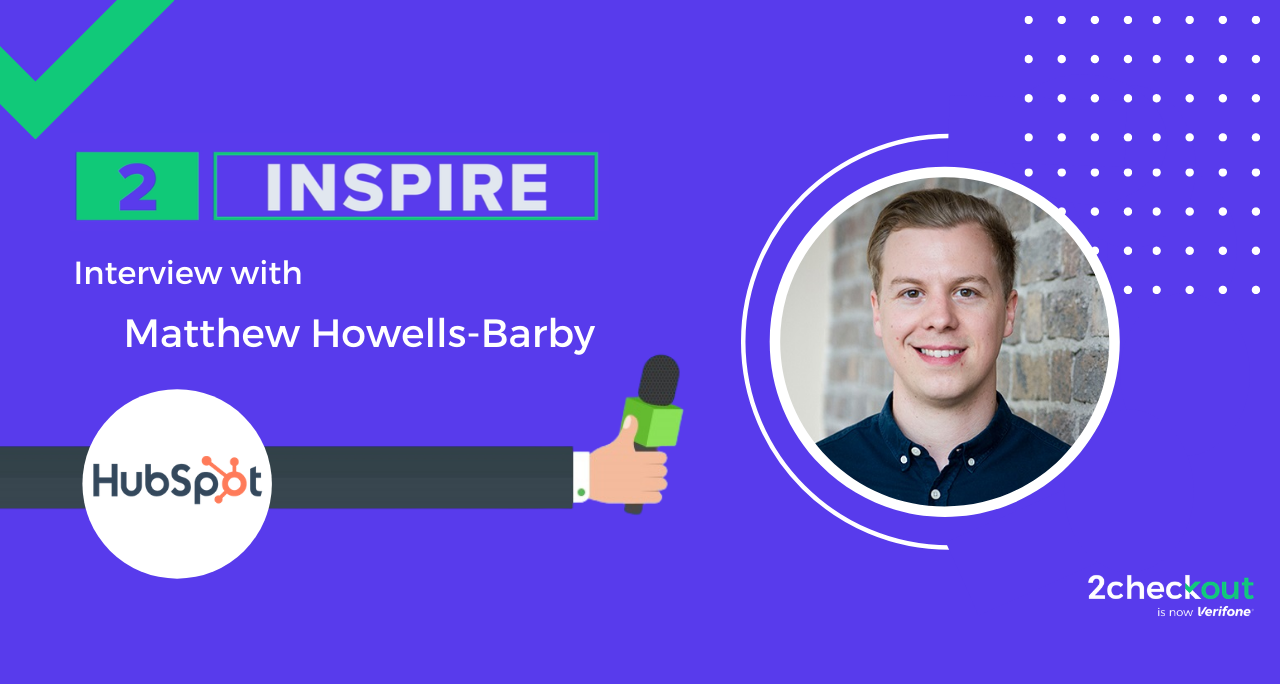Welcome back to our 2Inspire Interview Series, featuring entrepreneurs, managers, experts, and creatives in the eCommerce landscape. In our previous episode, SEO expert Will Critchlow shared his best resources, tools, and advice for making your eCommerce business stand out in SERPs. We hope you found a dose of inspiration in his insights – make sure to watch the full interview in case you haven’t yet.
In this episode, we had Matthew Howells-Barby join us for a chat. He is VP of Marketing at HubSpot (if you’re a marketer, this platform needs no introduction) and co-founder at Traffic Think Tank (a learning community for SEOs across the globe). Having developed a valuable business acumen, Matthew is also an advisor for a number of SaaS businesses. He regularly shares his tips and experiences as a global speaker at industry conferences like Inbound and, of course, SearchLove by Distilled.
We’ll learn more about Matthew’s journey in marketing, which has pivoted when the CEO of HubSpot noticed one of his articles and invited him to an interview – the rest is history. But beyond HubSpot, he is particularly passionate about community growth and engagement – he’s embedding communities in everything he does at HubSpot and in his side project, Traffic Think Tank. He further delves into pricing strategies for SaaS, and how you can leverage retention to build communities and drive further acquisitions. To learn about all these and much more, make sure to watch the full interview!
Check out the full interview below:
Transcript
Q1: Can you tell us a little bit about yourself and about your beginnings in the marketing field? (00:14)
I think like most people that get into marketing I kind of fell into marketing. When I was in university, I started kind of playing around with SEO. I got a job at a tiny agency that was nearby my university and I started to learn the business side of things. You know, this this was just as the rise of content marketing started to happen and the blogging revolution, so it was an interesting time in the space.
I was spending a lot of time working on my own personal brand, pushing out content that I thought was interesting and Brian Halligan, the CEO of HubSpot, somehow stumbled across an article that I wrote. Long story short, I was hired and moved from initially running and building the global search team then to owning the acquisition team and now I’m the VP of marketing.
Q2: From all the hats you’re wearing, what’s the closest to your heart and why? (01:11)
So aside from HubSpot, the thing that’s probably closest to my heart at the moment is Traffic Think Tank. It’s an online community and community building is something that I love. I’ve always been fascinated with how to build and cultivate engaged communities and I was fortunate enough in my career to go through several waves of major technological change. That dramatically changed how communities are formed whether that’s niche forums that I was involved in early on through to blogging, the rise of the sharing economy, marketplaces and now, where we sit, with the new wave of the creator or passion economy that is starting to form.
Q3: As a business advisor, what are some of the most common struggles you’ve seen founders deal with? (02:00)
It’s nearly always prioritization. This happens across companies of all stages but the repercussions of getting this wrong are really amplified when you’re an early-stage company. The areas where founders often struggle is that they either pick the wrong thing to spend all their time on or more commonly they peanut butter spread – they do a whole lot of things of very small amount and the net of that ends up being a whole lot of nothing. And I think that’s the key area of focus, outside of getting away from specific tactics and channels, everything’s different for every company.
Q4: What have been some eye-opening mistakes and the lessons you’ve derived from them during your career? (02:44)
There have been too many humbling moments that I have witnessed. Failing is really, really important, now learning from those failures is much more important. Your goal should not be not to fail, it’s not to make the same mistake twice. Mistakes come in all kinds of forms, it’s not about “Oh, I thought this tactic would work and it didn’t,” it’s like, well, as long as you evaluated the opportunity well and there was a chance, this is kind of good. I think the things where I’ve learned the most if I had to bucket a lot of these lessons into a single theme is understanding and learning how to influence people and influence their decisions and it’s about understanding what they care about.
Q5: How does a small company go from zero to hero in SERPs? (03:41)
There’s a lot of nuance here and I think this comes back to prioritization. Pulling the wrong lever is something that happens a lot – an example that I always come back to is that companies will start out trying to gain organic growth by say, all right we’re going to publish, let’s just take a simple example, we’re going to publish 10 blog posts per week and they don’t see results for a few weeks and they say okay, well, let’s try something different, let’s try 15 blog posts per week and then that doesn’t work and then they’re like, let’s try 20 blog posts per week, and then you apply that same logic to something like paid acquisition, you say we just will spend 100K this month on paid acquisition and we’re not seeing return on investment, let’s spend 200K the next month, let’s spend 500K, let’s spend a million the next month -you would never do that, right? But this happens a lot within organic search and it’s about understanding, like, you know, is that actually the right lever or is there something else we need to focus on?
Q6: How often should a company revisit its pricing strategy and what should they look at? (04:45)
First of all, in SaaS, you should be changing pricing and adjusting pricing very frequently. But if I had to give listeners right now one starting point it would be to understand the different ways to think about pricing and the approaches and frameworks and models to use for pricing. So, things like understanding the difference between value-based pricing, then you have cost-plus based pricing and then you’ve got things like competitor-based pricing. The challenge with those last two, right, is that it’s quite difficult to adjust pricing a lot because a lot of that pricing would be adjusting not necessarily in line with the perceived value of the product that your customers or potential customers see. With value-based pricing your price can be very fluid. I think this is the closest alignment you have which is like customer delight and willingness to pay for certain features in particular and aspects of your product or service offering and the actual price that you set for those products.
Q7: What customer acquisition channels have worked best for HubSpot (especially during this pandemic)? (05:59)
The big thing that we’ve probably seen some major tailwinds from has been driving people into educational content, especially near the start of the year around that, like, March to May period. During a lot of the first global lockdowns that happened people were very much in the spirit of “I’m gonna pour myself into education.” But our overall channel mix largely stayed the same, organic search being an enormous driver of net new customer acquisition and we’ve spent a lot of our time just doubling down on improving the customer experience and making sure that that is at a really high level and made some really good headway there.
Q8: Have you noticed any emerging acquisition strategies? (06:48)
One area that many companies forget about, which is unfortunate, is their existing customers. Community growth and engagement, something of course I’m very passionate about, is a huge driver of ongoing customer acquisition, of referrals, word of mouth, brand awareness and ultimately funnels in to help grow all of these other channels as well.
Q9: How do you see the B2B self-service and sales-assisted channels working in sync without conflict? (07:16)
This is very much a balance between getting the automation in place to facilitate some of those sales-assisted channels but making sure, as part of this, that the right companies are being pushed into the right motion. So, you probably don’t want to have some of those lower LTV customers or potential customers coming into a sales-assisted channel or sales-assisted motion where you’re going to be driving up your acquisition costs as a result of that, when actually you want to push them through a freemium motion that is touchless, without touching a sales rep. And I think one of the big piece in all of this, that we don’t have time to get into, is getting the balance right and the dynamic right of rep sales commissions and how this impacts incentives and all of this especially when you’re introducing a touchless sales kind of motion alongside a pre-existing sales-assisted motion.
Q10: How do you use retention as an acquisition strategy? (08:25)
I think that if you are focused on acquisition marketing you are missing a whole huge area of growth, if you’re not simultaneously thinking about the retention and monetization side of things. The role of the acquisition marketer doesn’t stop once you’ve acquired someone, you can’t just optimize for that. And again, this is why I’m so passionate about community growth as well.
First of all, you need to have really strong attribution all the way through and feeding the information on the retention and monetization of cohorts of individuals that you’re bringing through back into the acquisition side but, at the same time, you need to be engaging, regularly checking in with customers, making sure they’re feeling loved, that their requests are heard and that actions are taken upon them. Giving people a great customer experience directly influences your ability to acquire more. I think tying those together is essential.
Q11: How does a software/SaaS product stand out these days? (09:29)
We’ve seen with the pandemic and the shift to remote work has pushed forward digital transformation for several years now. There is a growing need in amongst all of this that’s coming in on that B2B side – that’s entrepreneur-friendly platforms I would say. And this is where we’ve seen a huge rise in things like the no-code kind of movement. But I think the fact that Shopify’s shop app is now actually the 35th most downloaded free app in the App Store – to give context to it, that is above Uber Eats, Google Photos, Tinder and Reddit – this tells this story pretty nicely. I think that while there is a lot more competition coming into this space there is an explosion of needs to be fulfilled with software right now.
Q12: What is an online tool you most rely on, and can recommend? (10:28)
When it comes to the tool I most rely on, honestly, it’s either my Google Calendar or it’s Todoist. Todoist is basically a to-do list and rough project management platform but I manage all of my tasks for work, side projects, personal tasks. I wouldn’t know how to function as a human being without these, so I think it’s a pretty good example of online tools that I truly do rely on.
Q13: Who are some inspirational people that you look up to and why? (11:07)
I think the first person on this list, for me, is Ben Horowitz. I have learned so much from his essays, his books. He’s an incredible leader and I think the way he thinks about leadership in particular shaped a lot of my thinking. Joanna Lord is someone that I would class as a good friend and also she’s the CMO over at Skyscanner, previously CMO at ClassPass. She’s someone that has followed a very similar career path that I hoped to follow in my own career and is an exceptional leader and someone that I look to as a real inspiration for myself and what I would like to be able to achieve. Two other people – Yuval Noah Harari, the writer of Sapiens series of books, fascinating individual. And a completely different example would actually be Jack Dorsey, CEO of Square and Twitter, he’s very multifaceted and is someone that makes great predictions, he puts his money where his mouth is, which I find particularly enjoyable to follow and impressive.
Q14: What is the best book you’ve read? (12:24)
I think similar to one of the, written by one of the people who I mentioned that I find very inspirational, Ben Horowitz, his book “The Hard Thing About Hard Things.” While I was reading that and rereading it, I just had so many moments of kind of connecting dots together that I’d really struggled to connect previously. And I think for anyone that’s going through and developing as a leader in any form, there’s times where it’s quite cathartic to read.
Q15: What is the best advice you’ve ever received? (13:03)
There’s a few things that always kind of come back to me and I think that one that’s held true to me, as simple as it is, is that, you know, you don’t need to be the loudest person in the room to be heard and in many ways the loudest person in the room is often not listened to. Being able to spend a much greater proportion of my time listening versus speaking, it’s often much easier to get your point across and to influence things that way.
Q16: What has been a highlight for you during this challenging year? (13:48)
For all of the craziness and stress that 2020 has brought me, I have many more wonderful memories with my daughter, so that’s absolutely a top memory for this year and for my life.
Stay in the know
We hope that these insights will give you the necessary impetus for moving your business forward. Make sure to watch our previous 2Inspire interviews as well.
- 2Inspire Interview with Will Critchlow, Founder of Distilled and SearchPilot
- 2Inspire Interview with Sujan Patel, Co-Founder of Mailshake
- 2Inspire Interview with Kevan Lee, VP Marketing at Buffer





